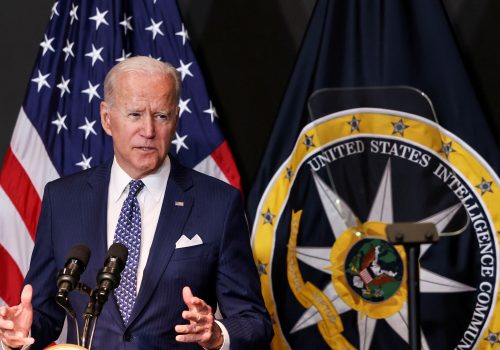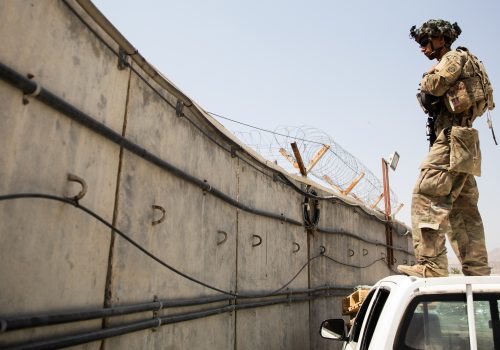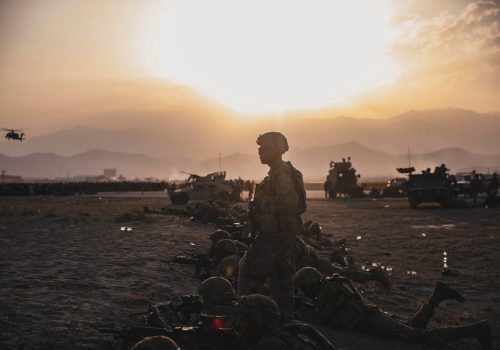How to avoid another state-building failure after Afghanistan
In 2009, I served as the US senior civilian representative in Kandahar, where I oversaw US civilian efforts to stabilize southern Afghanistan. These civilians, embedded in provincial and district governments throughout the region, provided insight into the effectiveness of the counterinsurgency-inspired state-building strategy. Their observations were prescient on the stunning collapse of the Afghan state and security forces we all have witnessed in recent weeks.
At that time, the Obama administration had deployed thirteen thousand troops and was debating sending up to eighty thousand more, along with hundreds of additional diplomats and civilian aid workers. As that debate unfolded, then US Ambassador to Afghanistan Karl Eikenberry flew from Kabul to Kandahar seeking an answer to one question: Would any security gains from increasing the number of US forces in Afghanistan be sustainable after the Afghan government and its security forces took the lead? When Eikenberry asked for an assessment based on US civilian operations in southern Afghanistan, I offered what seemed at the time an overly blunt response—that nearly all US and NATO gains would likely vanish due to the lack of Afghan capacity and will.
After observing the situation on the ground, Eikenberry agreed with this analysis. In the debate over sending more troops to Afghanistan to assist with state-building, he ultimately argued strongly against sending tens of thousands of additional troops. Then Vice President Joe Biden also vocally opposed a large-scale surge; however, the Pentagon persuaded the new president otherwise.
This debate is remarkable not because it brought up whether state-building would succeed, but because it brings up questions about why state-building became a primary objective, particularly after Osama bin Laden was killed in May 2011. Biden has made the point repeatedly that the United States won the war against al-Qaeda yet stayed to continue a declining state-building effort for more than a decade. As the United States ends its longest war, two critical questions about future US interventions remain: First, why did the United States continue a state-building policy after al-Qaeda was dismantled? And second, how can the United States learn to use force to negotiate the peaceful end to a conflict, instead of deciding to leave and then attempting to negotiate a withdrawal?
Here’s how the United States can do better:
1. Focus on achievable objectives
Overconfidence clouded US policymakers’ judgment about what they could realistically achieve in Afghanistan—a domain where others had already failed. This hubris, in some respects, was understandable after how quickly the US military and the Central Intelligence Agency toppled the Taliban regime in 2001.
However, in the aftermath, Afghanistan required realistic policymaking. The idea that the United States could create an Afghan National Defense and Security Force (ANDSF) capable of securing Afghanistan and linking its distant provinces to Kabul was unattainable—and that fact was readily available to policymakers.
For example, a senior Pakistani Army official in 2011 told a visiting senior US official that Afghanistan has never had a centralized army and that the United States—like the Soviets and British before—will eventually leave Afghanistan, and the US-created Afghan forces would collapse. He also predicted that the weapons the United States provided would end up in the hands of the Taliban and pose long-term problems for the region.
Capacity-building for Afghan governance was similarly unrealistic. For instance, a NATO International Security Assistance Force plan called for deploying several dozen Afghan civil servants in every contested district in southern Afghanistan. This became known as “government in a box,” but these kinds of people never materialized, so the goal of establishing robust, district-level governance—a linchpin of any counterinsurgency strategy—was never a realistic objective.
2. Increase civilian oversight at the Pentagon
The US military is trained to carry out complex and dangerous missions; it excels at them. The military’s optimism that it can achieve difficult tasks is laudable, but that optimism can cause it to extend its reach beyond overall policy objectives. Thus, civilian Pentagon leadership must steer the military toward achievable goals.
The expansion of the mission in Afghanistan from counterterrorism to a counterinsurgency-inspired state-building effort can be understood in this context. As the military developed its counterinsurgency strategy, civilian Pentagon leadership should have tempered that drive, particularly after bin Laden was killed in a raid in Abbottabad, Pakistan. Many Pentagon leaders supported objectives set by the military, instead of providing achievable policy goals. After the successful mission to kill bin Laden, for instance, the civilian leadership should have reoriented US forces to support nascent reconciliation talks with the Taliban, rather than press on with unachievable state-building.
3. Negotiate a peaceful conclusion to a conflict
In 2010, then US Secretary of State Hillary Clinton initiated negotiations with the Taliban to settle on an outcome to the war in Afghanistan. This process acknowledged that boosting the number of troops was not meeting US objectives. Jeff Hayes, then a defense intelligence agency analyst in the National Security Council, and I began meeting with a Taliban representative in December 2010. Soon after, Clinton gave a speech at the Asia Society laying out a US strategy to fight and talk with the Taliban at the same time. The talks then picked up momentum and by late 2011, when then US Special Representative for Afghanistan and Pakistan Marc Grossman led the talks, we seemed ready to allow the Taliban to open a political office in Qatar in exchange for a Taliban commitment to break ties with al-Qaeda and to negotiate a political settlement with the Afghan government. Unfortunately, the talks fell apart at the International Afghanistan Conference in Bonn, Germany, in December 2011 because then Afghan President Hamid Karzai walked away. Karzai had told Clinton at a meeting in Kabul in October 2011 to “go faster” in the negotiations with the Taliban, but at the Bonn Conference, he acted as if he had never heard of these discussions.
The primary lesson from these talks: The United States cannot use military force to negotiate a settlement to end a conflict. The Pentagon wanted to continue to conduct combat missions to compel the Taliban to surrender and reintegrate into the Afghan government (even though there was little evidence that would happen), while training the ANDSF to take over its combat role. The White House and parts of the US State Department, on the other hand, wanted to make reconciliation talks the primary focus of US policy. Unfortunately, this tension was never resolved, and perhaps Karzai’s change of position at Bonn could be understood as not comprehending US policy.
4. Recognize that history is not static
Working on Afghanistan, I was consistently frustrated that US policymakers viewed the motivations of actors in the conflict as static. No matter what new information we obtained, the analysis concluded that the Taliban is a group of extremists that could never reconcile with the Afghan government, but the Afghan government is a bastion of democracy that deserves unwavering US support. The Taliban, however, consistently told the United States from 2010 to 2012 that it wanted a future Afghanistan to remain engaged internationally, particularly for financial assistance, which would give the international community significant leverage over a future Afghanistan. The Afghan government, on the other hand, was deeply flawed, and its interests were not frequently aligned with those of the United States. Indeed, Afghan President Ashraf Ghani quickly abandoned his country, and the ANDSF that the United States spent nearly one hundred billion dollars on melted away without a fight. Nobody knows what the Taliban may do with its second chance at governing, and the group seldom misses an opportunity to disappoint, but it would be ironic if the Taliban and other Afghan groups can create an interim government only after the United States’ twenty-year nation-building dream fades from sight.
Afghans have suffered through more than four decades of conflict, and today’s crisis is heartbreaking for the international community, but Biden was correct to end the war. As its focus now shifts more toward near-peer competition with China, the United States must heed these lessons from Afghanistan to avoid another failed state-building experiment and to secure its continuing role as the world’s sole superpower.
Frank Ruggiero is a nonresident senior fellow in the Forward Defense practice at the Atlantic Council’s Scowcroft Center for Strategy and Security. He served as the US senior deputy special representative for Afghanistan and Pakistan from July 2010 to June 2012.
Further reading
Image: U.S. Secretary of State Antony Blinken leaves after delivering remarks following talks on the situation in Afghanistan, at the State Department in Washington, U.S., August 30, 2021. REUTERS/Jonathan Ernst/Pool


